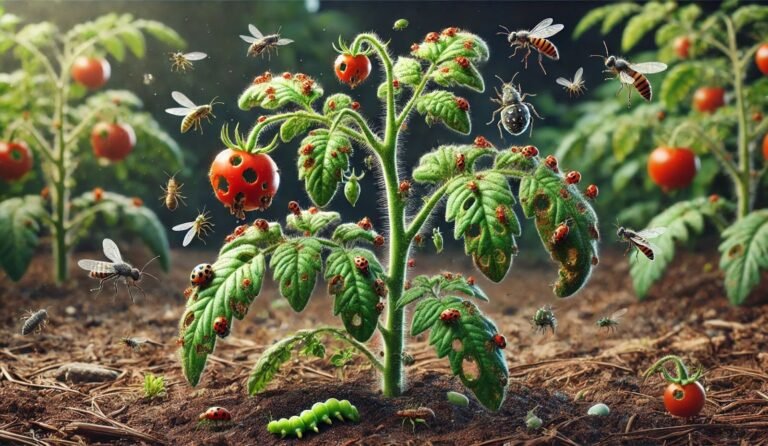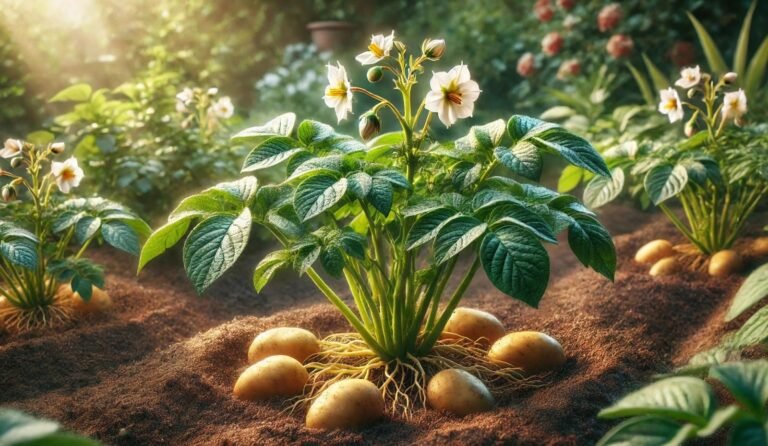Tomato Plants With Flowers But No Fruit: Solutions That Work
Tomato plants with flowers but no fruit can leave you scratching your head, wondering what went wrong. Is it the heat, poor pollination, or something else entirely? Don’t worry—you’re not alone, and the fix might be simpler than you think. In this guide, we’ll break down the most common culprits and share easy solutions to turn those stubborn blooms into juicy tomatoes. Ready to rescue your garden? Let’s dive in!
Why Do Tomato Plants Have Flowers But No Fruit?
Understanding the natural process of tomato flowering and fruiting is essential to diagnosing this issue. Tomato plants produce flowers as part of their reproductive cycle. These flowers must be pollinated for fruit to develop. However, when the process is interrupted, it can result in plenty of blooms but no tomatoes. This problem is surprisingly common, especially in home gardening setups where environmental factors or care routines might inadvertently hinder fruit production.
The Role of Pollination in Fruit Production
Pollination is the transfer of pollen from the male part of the flower (anther) to the female part (stigma). This step is crucial for the formation of tomatoes. Here’s how pollination impacts fruit production:
Self-Pollination in Tomatoes: Tomato plants are self-pollinating, meaning they have both male and female reproductive structures within the same flower. However, they still require some movement, such as wind or manual shaking, to transfer pollen effectively.
External Pollination Help: In natural outdoor settings, pollinators like bees and the wind play a vital role. Indoors or in greenhouses, the absence of these natural agents can result in flowers failing to set fruit.
Key Factors Influencing Pollination:
- Humidity levels: Excessively high or low humidity can make pollen sticky or dry, reducing its effectiveness.
- Lack of airflow: Without airflow, pollen doesn’t move between flower parts.
Common Misconceptions About Flowering vs. Fruiting
It’s easy to confuse a plant that’s flowering with one that’s fruiting. Let’s dispel a few misconceptions:
Myth 1: More Flowers Mean More Fruit
While flowers are a prerequisite for fruit, their presence alone doesn’t guarantee success. Pollination, environmental conditions, and plant health are equally critical.
Myth 2: Large Plants Always Produce Fruit
A large, healthy-looking tomato plant may prioritize foliage growth over fruit production if nutrients are unbalanced, such as excessive nitrogen.
Myth 3: All Varieties Behave the Same
Some tomato varieties are more sensitive to environmental factors, making them less productive under certain conditions.
Common Causes of Tomato Plants Not Fruiting
1. Poor Pollination
Description: Without proper pollination, flowers will bloom but fail to develop fruit.
Signs: Flowers may drop off or remain intact without forming small green tomatoes.
Causes: Lack of pollinators, insufficient airflow, and indoor environments.
2. Temperature Stress
Description: Tomatoes are highly sensitive to temperature changes.
Ideal Conditions: 70–85°F (21–29°C) during the day and 55–70°F (13–21°C) at night.
Effects:
- High heat (>85°F) can cause flowers to drop, a condition known as “blossom drop.“
- Cold temperatures (<55°F) can hinder pollination and fruit set.
3. Nutrient Imbalance
Description: Excessive nitrogen can lead to lush foliage but inhibit fruit production.
Balanced Fertilization: Tomatoes require a mix of nitrogen, phosphorus, and potassium, with more emphasis on phosphorus and potassium for fruiting.
4. Water Stress
Description: Irregular watering disrupts the plant’s ability to absorb nutrients.
Signs:
- Overwatering: Leads to root rot, reducing plant vigor.
- Underwatering: Causes flowers to wilt and drop.
5. Pruning Mistakes
Description: Over-pruning or removing key branches can stress the plant.
Solution: Prune only the unnecessary lower leaves and suckers to focus energy on fruit production.
6. Spacing
Description: If tomatoes are planted too close together, they will produce fewer fruits and are more susceptible to common tomato diseases.
Solution: Tomato plants should be spaced between 24 and 36 inches (60-90 cm) apart.
Solutions for Tomato Plants With Flowers But No Fruit

1. Hand-Pollination Techniques
Method: Use a small brush, electric toothbrush, or gently shake the plant to mimic natural pollination.
When to Pollinate: Perform this early in the morning when pollen is most viable.
2. Creating Optimal Growing Conditions
Temperature Control: Use shade cloths or row covers to shield plants from extreme temperatures.
Humidity: Maintain 40–70% humidity for optimal pollen transfer.
3. Using Balanced Fertilizers
Recommendation: Apply a fertilizer with a ratio like 5-10-10 or 10-20-20. Avoid excessive nitrogen fertilizers.
Frequency: Feed plants every 2–3 weeks during the flowering and fruiting stages.
4. Proper Watering and Pruning Methods
Watering: Provide consistent moisture, aiming for about 1–1.5 inches of water per week.
Pruning: Remove yellowing or damaged leaves but leave the fruit-bearing branches intact.
Preventing the Problem in Future Tomato Plants
1. Choose the Right Variety for Your Climate
Types to Consider:
- Heat-tolerant varieties like “Heatmaster” or “Solar Fire.”
- Short-season varieties for colder climates.
2. Regular Monitoring and Maintenance
Check for signs of stress, pests, or diseases regularly. Adjust watering and feeding schedules as needed.
3. Companion Planting to Attract Pollinators
Best Companions: Marigolds, basil, and borage attract beneficial insects.
Benefits: Encourages a natural ecosystem that supports pollination.
FAQ
Why are my tomato flowers falling off?
Likely due to temperature stress, poor pollination, or water irregularities.
How can I improve pollination indoors?
Use a fan to create airflow and hand-pollinate with a small brush.
What fertilizer works best for tomato fruiting?
Use a low-nitrogen, high-phosphorus fertilizer like 5-10-10.
How long does it take for tomatoes to form after flowering?
Typically, 20–30 days after pollination, depending on the variety.
Final Thoughts
Growing tomatoes successfully is a rewarding process, but challenges like flowering without fruit can be discouraging. By understanding the causes, applying the right solutions, and taking preventive measures, you can enjoy a bountiful harvest. With patience and proper care, your tomato gardening experience will not only be productive but also deeply satisfying. Start your tomato journey today with these insights, and watch your backyard or indoor garden thrive!







